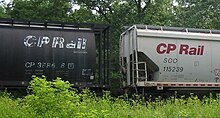Reporting mark

A reporting mark is a two-, three-, or four-letter alphabetic code used to identify owners or lessees of rolling stock and other equipment used on the North American railroad network. The marks are stenciled on each piece of equipment, along with a one- to six-digit number, which together uniquely identify every such rail car. This allows the cars to be tracked by the railroad they are traveling over, which shares the information with other railroads and customers.[1][2]
Standard practices
The Association of American Railroads assigns marks to all carriers, under authority granted by the US Surface Transportation Board, Canadian Transportation Agency, and Mexican Government. Under current practice, the first letter must match the initial letter of the railroad name. As it also acts as a Standard Carrier Alpha Code, the reporting mark cannot conflict with codes in use by other nonrail carriers.[1][2]
Marks ending in X are assigned to companies which or individuals who own railcars, but are not operating railroads; for example, the TTX Company (formerly Trailer Train Company) is named for its original reporting mark of TTX. In another example, the reporting mark for state-funded Amtrak services in California is CDTX (whereas the usual Amtrak mark is AMTK) because the state transportation authority Caltrans owns the used cars. This is why the reporting mark for CSX Transportation, which is an operating railroad, is CSXT instead of CSX.
Companies owning trailers used in trailer-on-flatcar service are assigned marks ending in Z, and the National Motor Freight Traffic Association, which maintains the list of Standard Carrier Alpha Codes, assigns marks ending in U to owners of intermodal containers.[1][2]
When the owner of a reporting mark is taken over by another company, the old mark remains the property of the new company. For example, when the Union Pacific Railroad (mark UP) acquired the Chicago and North Western Railway (mark CNW) in the 1990s, it retained the CNW mark rather than immediately repaint all acquired equipment. Some companies own several marks that are used to identify different classes of cars, such as boxcars or gondolas.[2] If the acquiring company discontinues the name or mark of the acquired company, the discontinued mark is referred to as a "fallen flag" railway.
-
A covered hopper with SHPX markings
List of reporting marks
Due to this list's size, it has been split into subpages based on the first letter of the reporting mark. Railinc Corporation, a subsidiary of the AAR, maintains the active reporting marks for the North American rail industry. Railinc offers a free online look-up of reporting marks and other industry reference files through the Railinc IRFi website.
See also
- UIC Country Code – A series of prefixes used on rolling stock identification numbers by members of the International Union of Railways (UIC) to identify the country of origin of railway rolling stock
References
External links
- Nakina.Net – Reporting Marks – Unofficial incomplete compilation of reporting marks from the 1920s to the present day, as listed in the Official Railway Equipment Register. (Does not include U & Z markings.)
- National Railway Historical Society Railroad Reporting Marks (2001)
- Railinc Industry Reference File Look-up – search Railinc's free reporting mark look-up by markings (current marks only)
- Association of American Railroads (AAR) Reporting Marks



